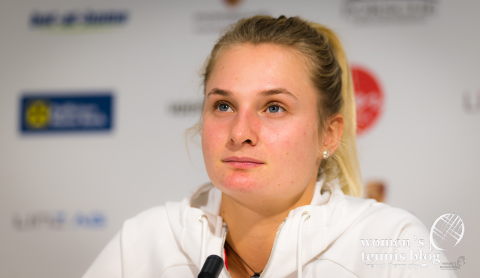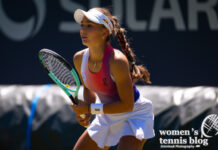The post-Wimbledon WTA rankings are lifting runner-up Serena Williams an amazing 153 places back into the Top 30 and champion Angelique Kerber back into the Top 5, but what attracted my attention this Monday was that Ukrainian teenager Dayana Yastremska became the first player born in 2000s to crack the Top 100.

At the age of 18 years and two months, Yastremska is debuting at a career-high ranking of No.100 after making the semifinals of a 100K tournament in Budapest, Hungary, the feat that followed her title run at a 60K event in Rome and runner-up finish at two 100K tournaments. Yastremska is yet to play the main draw of a Grand Slam, although as a junior she reached the final of Wimbledon 2016.
While players born in early 2000s are incredibly young, I have to notice that the fact that an 18-year-old is the youngest player in the Top 100 makes me think that nowadays players tend to excel later in their careers. Just for reference, Martina Hingis won the 1997 Australian Open at age 16 years and 3 months, while soon afterwards she climbed to the top of the rankings, Maria Sharapova won Wimbledon 2004 aged 17 years and 75 days, ending the year ranked No.4, and there are many more examples, these are just off the top of my head.
While nowadays we have more players than ever that make their greatest achievements after celebrating their 30th birthday, it seems that millenials also tend to take greater time to get their careers into higher gear. Have you noticed this? What do you think could be the reason for this trend?





Today women’s tennis is a much different game than when Hingis and Austin started out as super teenagers. Players hit harder and are more muscular today. They workout more, lift weights, run and are in better shape now than ever. It takes a few more years of maturity to make a great player now. Maria was an exception. Read her book if you want to know why.
Many players today see the value of a free $250,000 college degree from a top university as a chance to learn as they mature. After obtaining a degree, the best go pro.
Today we have great young 20, 21 and 22 year old players who are like those teenagers of years past.
It’s also a function of more experienced players hanging around the game, just like on the ATP side. When players remain competitive into their 30s, it deprives (for lack of a better word) the next generation or so some experience and opportunities. Stunts their growth.
It also could be a function of more experienced players hanging around the game, just like on the ATP side. When players remain competitive into their 30s, it deprives (for lack of a better word) the next generation or so some experience and opportunities. Stunts their growth.
Saw her play in Cagnes-sur-Mer. An exceptionally gifted player.